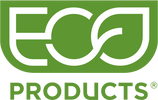CIRC Contamination Mitigation Program
A new program developed by Eco-Products to address the challenge of contamination from non-compostable materials in compost streams through a systems approach to Procurement, Operations, Communication, and Composter & Hauler Engagement.
What is CIRC?
CIRC (Controls Intended to Remove Contamination) is a scalable, “generator-focused” (think Restaurants, Stadiums, Venues, etc.) contamination mitigation program. It is not a third-party certification, but rather a collection of free, open-source resources to improve composting systems. In other words, you don't need to be an Eco-Products customer to use or benefit from the program.
CIRC is designed to do three things:
1. Systematically control and mitigate contamination from non-compostable materials
2. Increase composter confidence in organics streams that contain post-consumer food scraps and certified compostable packaging
3. Demonstrate that a systems approach to contamination mitigation is possible in an array of foodservice environments.
At its most basic level, CIRC is a set of customizable tools and frameworks designed to build trust and process between generators, composters, haulers, distributors, and manufacturers.
Why do we need it?
Contamination from non-compostable products and materials is one of the biggest,
if not the biggest, problem facing composters
accepting material from post-consumer sources.
Consumer education is low and most composters have
a limited ability to deal with contamination once it gets to their facilities.
This means that a contamination mitigation system that begins with procurement
and extends through operations, communications, and composter/hauler engagement
must be in place if we expect to send composters
a post-consumer organics stream they can work with.
Who is it For?
The CIRC Program is designed for a specific set of audiences – all of whom play a critical role in keeping foodservice organics out of landfills.
Generators (Restaurants, Stadiums, Venues, etc)
Generators, and the compost streams they are creating and sending to composters, are the focal point for CIRC. The whole program is aimed at preventing non-compostable items from getting into generator compost streams, and making sure that only agreed upon compostable materials are being sent to composters.
Manufacturers
Compostable product manufacturers must provide accurate information about their products, secure distributor stocking positions for approved items, and assist with ordering as needed. The Eco-Products PZW team exists to do exactly this kind of work, and will manage the CIRC process for Eco-Products customers every step of the way.
Distributors and other Procurement partners
Distributors are responsible for maintaining inventories of certified compostable products that have been approved for collection and processing by composters, and meet the business needs of the generator. This is an extremely critical piece of the equation, as controlling what flows into an operation is the best way to keep non-compostable material out of the compost stream.
Haulers
Haulers collect compost (and possibly other waste streams) from the generator, and deliver it to composters. Most haulers that collect post-consumer organics are well-versed in contamination, and will do some form of load inspection at pick-up. This makes them the first independent reviewer of the compost stream, and a valuable first check on the effectiveness of contamination controls.
Composters
Composters determine what materials they will accept and process in their facilities, and ultimately decide whether or not accepting food scraps and compostable packaging is possible for their business. Providing composters with contaminant-free streams is the goal of the CIRC program, and should be the goal of every stakeholder in the organics diversion value chain.
The Scorecard
The core resource in the CIRC toolkit is a menu of recommended contamination controls spanning Procurement, Operations, Communication, and Composter & Hauler Engagement that we call “the scorecard”.
Each section has a list of controls that have been identified by stakeholders from across the organics diversion value chain as useful in contamination mitigation efforts.
The idea is that each generator will identify a list of controls that make the most sense for their business, and that list will be reviewed and agreed upon by their distribution and other procurement partners, key internal staff, and the haulers and composters who will collect and process the material.
If those controls can be implemented successfully and consistently, the result should be cleaner compost streams and an increased likelihood that access to composting for food scraps and packaging will be a viable option over the long term.
additional Resources
Putting an effective contamination mitigation program in place that delivers consistently clean streams of organics to composters is no small feat, and we’re committed to supporting you in every way we can. The resources below are just a start, so check back often for additions to this list.
CIRC OVERVIEW
Most of the information that is on this webpage consolidated into an easy to share document.
SAMPLE ORDER GUIDE
This document should be the single source of truth for what compostable products have been approved by the composter, and need to be stocked by the distributor so that generators and their procurement partners can regularly and confidently order them.
SCORECARD SECTION OVERVIEWS
These documents provide additional detail on the objectives of each section of the Scorecard
COMING SOON
• Assessing your operation’s contamination risk factors
• Sample Vendor Agreement Template
• Sample Signage (sorting posters, bin signage, example in-venue and out of venue comms)
• Updated Zero Waste Toolkit
